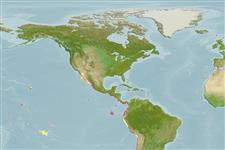>
Carangaria/misc (Various families in series Carangaria) >
Centropomidae (Snooks)
Etymology: Centropomus: Greek, kentron = sting + Greek, poma, -atos = cover, operculum (Ref. 45335).
More on author: Günther.
Environment: milieu / climate zone / rango de profundidad / distribution range
Ecología
marino; agua dulce; salobre demersal. Tropical; 29°N - 6°S, 113°W - 76°W (Ref. 129711)
Eastern Pacific: southern Baja California, Mexico and mouth of the Gulf of California to Colombia and Peru.
Tamaño / Peso / Age
Madurez: Lm ? range ? - ? cm
Max length : 123 cm TL macho / no sexado; (Ref. 40637); common length : 45.0 cm TL macho / no sexado; (Ref. 55763); peso máximo publicado: 26.2 kg (Ref. 40637)
Short description
Claves de identificación | Morfología | Morfometría
Body slender and not very deep; dorsal profile slightly concave behind the eyes; lateral line extending to posterior edge of caudal fin; second anal spine, when folded down, well removed from origin of caudal fin; pectoral and pelvic fins sub-equal; anal fin with 6 rays; back blue gray; belly white; lateral line very dark; fins charcoal gray (Ref. 55763).
Body shape (shape guide): fusiform / normal.
Adults enter mangrove areas and lagoons. Also occur in estuaries (Ref. 11035) and fresh water (Ref. 4537), as well as rustic ponds (Ref. 85798).
Life cycle and mating behavior
Madurez | Reproducción | Puesta | Huevos | Fecundidad | Larva
Bussing, W.A., 1995. Centropomidae. Róbalos. p. 987-995. In W. Fischer, F. Krupp, W. Schneider, C. Sommer, K.E. Carpenter and V. Niem (eds.) Guia FAO para Identification de Especies para lo Fines de la Pesca. Pacifico Centro-Oriental. 3 Vols. FAO, Rome. (Ref. 9284)
IUCN Red List Status (Ref. 130435: Version 2024-2)
Threat to humans
Harmless
Human uses
Pesquerías: comercial; pesca deportiva: si
Herramientas
Special reports
Download XML
Fuentes de Internet
Estimates based on models
Preferred temperature (Referencia
123201): 22.8 - 29.1, mean 26.9 °C (based on 207 cells).
Phylogenetic diversity index (Referencia
82804): PD
50 = 0.5002 [Uniqueness, from 0.5 = low to 2.0 = high].
Bayesian length-weight: a=0.00724 (0.00462 - 0.01137), b=3.02 (2.89 - 3.15), in cm total length, based on LWR estimates for this species & Genus-body shape (Ref.
93245).
Nivel trófico (Referencia
69278): 4.2 ±0.7 se; based on size and trophs of closest relatives
Resiliencia (Referencia
120179): Medio, población duplicada en un tiempo mínimo de 1.4-4.4 años (Preliminary K or Fecundity.).
Fishing Vulnerability (Ref.
59153): High to very high vulnerability (74 of 100).
🛈
